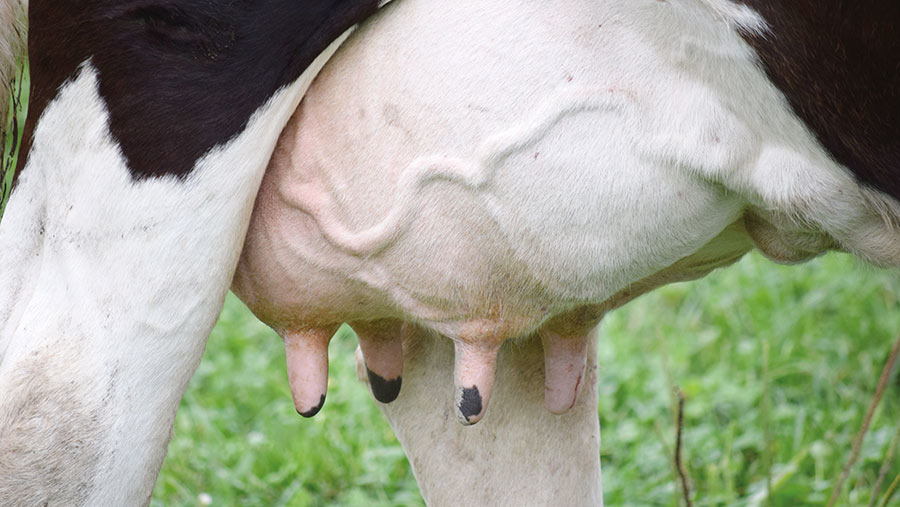4 ways to assess the true cost of mastitis to your farm
 © A Takahashi/Adobe Stock
© A Takahashi/Adobe Stock The cost of a case of mastitis is used to calculate the total annual expense to a herd. This figure is then used to estimate return on investment (ROI) in mastitis control measures.
The calculation commonly uses “national average” values. Unfortunately, there is such a wide difference in costs from farm to farm, that the resulting figure is unlikely to represent the true cost to your business.
See also: How to get staff on board to cut mastitis in your dairy herd
Overestimating mastitis losses leads to a lower ROI, while underestimating may lead to lack of investment in valuable preventative measures.
There is always a degree of error in calculating something as complicated as mastitis economics, but by using readily available information from your farm, we can get a more accurate cost of your mastitis cases.
The four main financial components of mastitis are:
- Treatment: cost of medicines, cost of labour and loss of revenue from milk withdrawal period
- Milk revenue: penalties or lost bonuses caused by reduced milk quality
- Production: loss of yield due to temporary or permanent changes to the udder tissue
- Herd replacements: cost of replacing animals and losses from lower production.
Treatment costs and changes to milk price are easy to work out, but production losses and replacement finances are complicated and often calculated incorrectly.
There are four points that need considering to ensure reliable estimates of these costs:
1. The link between clinical cases and high somatic cell count
A fundamental problem with mastitis cost estimates is that both clinical and subclinical cases have an impact on yield, but a high somatic cell count and a case of mastitis may be caused by the same infection.
This leads to the risk of counting the cost of lost yield twice for a single infection: first for the clinical case, then for the high cell count.
- Data analysis shows the usual ratios of clinical to subclinical cases for different bacteria. With Streptococcus uberis, for example, 56% of infections will be subclinical, 21% clinical and 23% will cause both.
- Experimental work has established the yield losses we are likely to see from clinical and subclinical cases for different bacteria.
- We apply these principles to each herd’s mastitis data to ensure we count the full yield loss, but do not “double-count” these costs.
2. Main mastitis pathogens
Different bacteria species produce yield losses of different sizes and durations. This is partly due to whether they are more prone to causing clinical or subclinical infection.
It is also influenced by the time of lactation they tend to occur, and by other bacterial “virulence factors”.
- Working out which bacteria are most common in your herd gives important information for calculating milk loss.
- For example, clinical cases of E coli may reduce lactation yield by up to 3.5kg/day, whereas Streptoccus uberis mastitis will have a lower milk loss of around 1.5 kg/day.
- For herds affected by multiple pathogens, we can allocate cases proportionally between different species.
- Combining bacteria type with the risk period within the lactation, and the ratio of clinical to subclinical infections, increases the accuracy of yield loss estimates.
3. Risk periods within lactation
The earlier that infection occurs during lactation, the greater the lost yield.
This is because yields are higher earlier in lactation, and because there is a greater period available for ongoing losses and a higher risk of subsequent cases.
- If most cases occur in the first 60 days of lactation, the economic impact is substantially higher than infections later in lactation.
- Following the first 60 days, there is a gradual reduction in mastitis cost over the rest of the lactation.
- Some herds have most cases within a particular time period, and we can tailor the cost profile to this.
- Other herds may see a spread of cases throughout lactation, meaning the cost calculation needs adjusting based on the proportion of infections in each period.
4. Udder health replacement costs
Replacement costs are often oversimplified, but subtle details make a big difference to the bottom line.
- When calculating sale price of udder health culls, we must also factor in the negative value of disposing of any fallen stock caused by mastitis.
- If replacing cows with heifers, we need to account for the lower yields that first-lactation animals produce. Heifers normally yield 10-15% less, but on-farm data will give an accurate figure.
- Lower heifer yields are partially mitigated by lower feed costs. We use feed cost/litre to calculate savings for heifers compared with cows.
- It is also important to factor in the mastitis risk of heifers compared with cows. In most herds, mastitis rate in heifers is significantly lower, meaning replacements are likely to reduce udder health costs.
These contributing factors can seem highly complex and daunting, which is why many advisers prefer to fall back on national averages for their cost calculation.
However, using a “cost calculator” that incorporates these cost areas allows us to generate reliable figures quickly and simply with data readily available on most farms.

